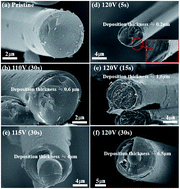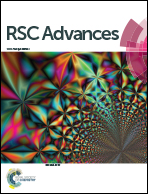Electro-conductively deposited carbon fibers for power controllable heating elements†
Abstract
Carbon fibers are considered as one of the promising heating elements in various industrial applications because of their excellent thermal stability and electrical conductivity. In order to achieve controllability of the power output, gas-phase carbon deposition was carried out on the surface of carbon fibers by flowing a mixture of liquefied petroleum gas and hydrogen via electro-conduction chemical vapor deposition. We confirmed the tuning ability of the temperature ranging from 800 to 1330 °C. The microtexture of the deposited carbon was sequentially changed; the initial layer with small-sized domains, the intermediate layer with medium crystallinity, and the top layer with large-sized domains and high crystallinity. However, the linear decrease in the electrical conductivity of the heating elements was ascribed to the change in the growing direction of the crystallites from a longitudinal to a perpendicular direction with respect to the fibers. The wide range of power output for our carbon fiber composites from 270 to 448 W at 50 V will be useful for various industrial electric heating applications.


 Please wait while we load your content...
Please wait while we load your content...